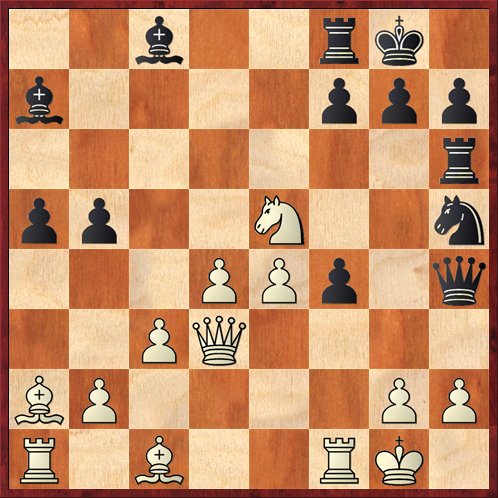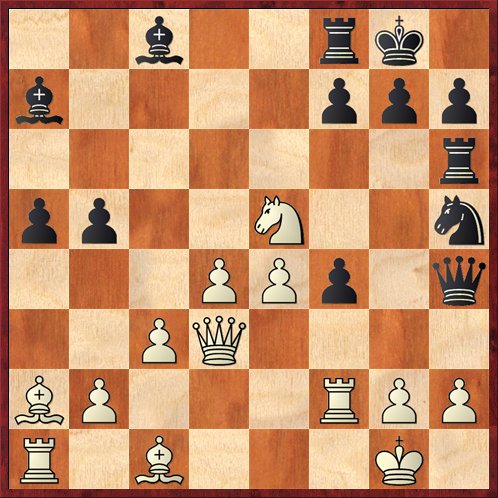It was just yesterday that I was watching a steady stream of queenside openings, flank openings, etc. and thinking, “Wouldn’t be great if just once I could see a King’s Gambit in this tournament?”
Well, today Aleksandr Shimanov granted my wish! The 21-year-old grandmaster from Saint Petersburg was in a desperate situation, down 1-0 in his match against the strongly favored Gata Kamsky, who is known as a very difficult person to beat. Shimanov was desperate enough to play the King’s Gambit, an opening that as far as I can tell, he had never played in a serious tournament in his life! (At least going back to 2005 when he started to play at the international level.)
Not only did Shimanov play the King’s Gambit, he also played what I consider the correct continuation, the Bishop’s Gambit 1. e4 e5 2. f4 ef 3. Bc4. Kamsky immediately returned the pawn with 3. … d5 4. Bxd5. On the tournament website they called this the “Bledow Countergambit,” a name I have never heard. However, I have played against 3. … d5 several times and I can tell you that it does not strike terror into the heart of a King’s Gambiteer. Both sides get active play, and active play is what the King’s Gambit is about.
Anyway, the opening worked quite well for Shimanov. Kamsky must have been taken completely off guard, and he developed his pieces in a surprisingly artificial, non-Kamsky-esque manner. By move 19 the computer already evaluated Shimanov’s position as +4 pawns (!!) and then the madness started.
FEN: 2b2rk1/b4ppp/7r/pp2N2n/3PPp1q/2PQ4/BP4PP/R1B2RK1 w – – 0 20
Here I do not think that any King’s Gambiteer would hesitate to play the crushing move 20. Nxf7! After all, sacrifices at f7 are what the King’s Gambit is about. And this isn’t even a sacrifice, really. After 20. … Rxf7 21. Qxb5 (threatening mate on e8) Qe7 22. Bxf7+ Qxf7 (or Kxf7) 23. Rxa5 White has rook and two pawns for two pieces, Black’s king is exposed and the game will probably be over pretty soon.
Now it’s true that after 20. Nxf7 Rxf7 21. Qxb5 there is another tactical possibility for Black that has to be calculated, but it doesn’t work. I’m not going to tell you what it is yet, because that would be giving away the punch line of the story.
Instead Shimanov played the comic/tragic move 20. Rf2??, a move that is unbelievably bad. First, it’s an error of omission. White didn’t need to play defense. A true King’s Gambiteer would cringe to see this move. But remember, Shimanov isn’t a true King’s Gambiteer. He was just trying to solidify the position. But here’s the second problem — 20. Rf2 doesn’t do that either! It’s now Black to play and win.
FEN: 2b2rk1/b4ppp/7r/pp2N2n/3PPp1q/2PQ4/BP3RPP/R1B3K1 b – – 0 20
Do you see what Kamsky and Shimanov both missed? As Matt Hayes already wrote in a comment on my last post, it’s a combination that even a class-A player ought to see, let alone a grandmaster who is not in time trouble.
The answer is 20. … Qxh2+!! If White accepts the queen sacrifice he’s checkmated in two after 21. Kxh2 Ng3+ 22. Kg1 Rh1 mate. And if he declines it’s pretty obviously bad news after 21. Kf1 Ng3+.
This was a pretty unbelievable thing for Kamsky to miss. Here’s what the broadcasters had to say. Lawrence Trent: “The only way that you can get over a mistake like this is with a nice bottle of Scotch.” Susan Polgar: “I don’t want to be harsh, but this was criminal for someone of Gata’s strength.” But she did tell the story of how she herself once missed a shot like this, something that she would expect her students to be able to find.
Instead Kamsky played 20. … Ng3??, which would be great if White had to accept the sac. But Shimanov regrouped with 21. Nf3, and now White was back to being much better.
Even so, the craziness didn’t stop! I don’t know whether Shimanov realized what had happened and was still rattled, or whether he had just lost his feeling for the position, but in any event he defended atrociously, let his king get chased out into the open, and within 10 moves the computer was showing Kamsky with a +5 pawn advantage!
But then Kamsky went crazy, too. I can’t really explain this, but it looks as if he became obsessed with queening a pawn rather than attacking Black’s king. Once again the game swung wildly in White’s favor, and by the time the players reached the time control on move 40, it was back to +4 pawns in White’s favor.
It was more like a blitz game than a serious game. I don’t know if I’ve seen another GM game with five swings of this magnitude — first one player up by more than 4 pawns, then the other, then the first, then the second, and finally the first. Well, I’m sure it has happened, but it was pretty embarrassing for both participants. Anyway, after move 40 it was just a mop-up for Shimanov, so he has pulled even with Kamsky at 1-1.
I’m kind of sad about all the mistakes, because the result is that nobody will take the game seriously and they will continue to think that the King’s Gambit is not a serious opening. Oh, well. Let them. As Francisco Vallejo Pons, who was in the studio at the time, said, “The problem with the King’s Gambit is that when you analyze it on the computer it looks really bad, but then you play it and it’s not so easy!”
Probably the biggest headlines of the day were not generated by Shimanov and Kamsky but by the 14-year-old Chinese GM, Wei Yi, who scored his second consecutive huge upset. As you might remember, he beat #24 Ian Nepomniachtchi in round 1. Today he played a beautiful game against Alexei Shirov, sacrificing a piece for three connected passed pawns on the queenside and batting away all of Shirov’s attempts to complicate matters. Admittedly Shirov seemed to be off form in this tournament, but the world’s youngest GM, Wei Yi, is clearly the real deal.
The second-biggest surprise of round 1, Indian GM Baskaran Adhiban, also made it through round 2 by beating Alexandr Fier. This would also count as sensational news (two players seeded below #100 making it into the top 32!), however it is not quite as big a surprise as Wei Yi’s victory because Fier was also a “Cinderella.” The fates have been extremely kind to Adhiban, as he won from a lost position against Alekseev and then did not have to play a super-GM in round 2. But next round he will have to face Nakamura, and I think that might be the end of his Cinderella dreams. Wei will probably face Mamedyarov. From the way he’s played so far, I think you have to give him a serious chance.
One more little comment: I am so glad that the commentators, Susan Polgar and Lawrence Trent, are not looking at computer analysis. It’s hard to ignore it, because the live feed on the website shows you Houdini’s evaluation of each position, but I am convinced that looking at Houdini will spoil your enjoyment of the games (at least partially).
The reason is that Houdini already factors in the good moves, but it makes the bad moves look spectacularly bad. You see the position go from +4 to -6, as in the Shimanov-Kamsky game, and you immediately know that somebody made a big mistake, and then you click over to that game to see what happened. In the pre-computer age, the big commotion in the tournament hall would come when somebody played a brilliant sacrifice. Remember Marshall’s “shower of gold coins” game?
Now, however, the big commotion in the “virtual” tournament hall (the Twitter-verse) happens when somebody blunders. So what everybody wants to talk about is, “How could Kamsky miss that queen sac?” Instead of, “What a beautiful game Wei Yi played!”
So do yourself a favor, if you’re watching. Try not to look at the computer evaluations.





{ 2 comments… read them below or add one }
You can turn off the Houdini evaluations on the live site by clicking the gear icon beneath the board.
Wow. Just wow. Could Kamsky possibly have been in time trouble by move 20? And what were both player even thinking about if not …Qxh2+! (Doesn’t merit two exclams.)
{ 1 trackback }